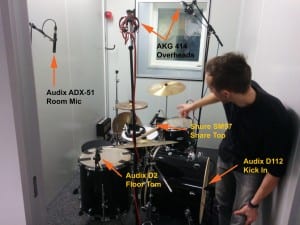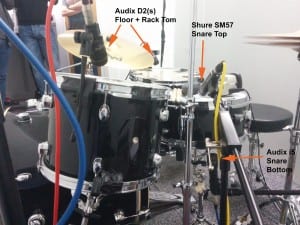James Woodliffe had his turn in front of the mic this week, as we were recording the vocal track for the mix. Ross was in charge of Pro Tools, Adam was on the desk, and Alex and James Glenister acted as the engineers, setting up the mics we would be using this session. All of these had pop filters, to reduce the pop produced from any plosives. The mics were as follows:
- A Shure SM57. Another versatile mic. Its frequency response is quite similar to that of the SM58, a very affordable mic, which has a boost in the high mids where vocals tend to lie. There are no other settings to list.
- An Electro-Voice RE-20. This is a large diaphragm dynamic mic, and interestingly enough has no proximity effect, so is very popular for vocalists and broadcasters as a result. Alex and James G set this up with the Low Shelf setting switched on.
- An AKG 414. A staple mic, very versatile and good for vocals. We had previously used this mic for James’ guide vocals, which sounded very good, if a little rough, though that could be excused somewhat. This was set up in cardioid, with a bass roll off enabled at 160Hz.
With the desk zeroed and the Pro Tools session set up, we prepared to test the mics. Luke told us that finding the best mic for a singer’s voice was of the utmost importance for both the outcome of the track, and for the performance of the singer. Taking the time to find the best mic for a singer’s voice lets them know that you care about their performance, which can help to set them at ease.
The SM57 was the first mic we tested. On its own, the mic sounded very good. The sibilance in James’ voice was strong, and it sounded full and well rounded. The next mic was the RE-20, which has a very flat frequency response. This was very uniform and clear, but I felt like it lacked some of the strength that the SM57 had. We then tested the 414, which sounded alright, but I felt it was rather airy, and the appearance of a proximity effect was noticeable. This mic did possess more strength and punch than the RE–20 though. After these tests, I thought that the SM57 was the better mic, however, we then had James sing over the rest of the track, and there were a few points where the SM57 produced some overly high tones, which cut through the rest of the song. We eventually came to the conclusion that the flat, clear response of the RE-20 was the best fit, and so chose this mic to record with.
The first take was very good, though there were some slip ups, namely with the second chorus and the final vocal section at the end of the song. These were both fixed easily with the use of a pre-roll of 8 seconds. We re-recorded the second chorus twice and then finished off the session by redoing the final vocals.
I thought that the final line before the solo was a little quiet, and so may consider boosting that section in my individual mix. The guitar was also at odds with the vocals sometimes, so I think I’ll tone those down too. Overall though, the session was a great success, and the vocals sounded excellent.

